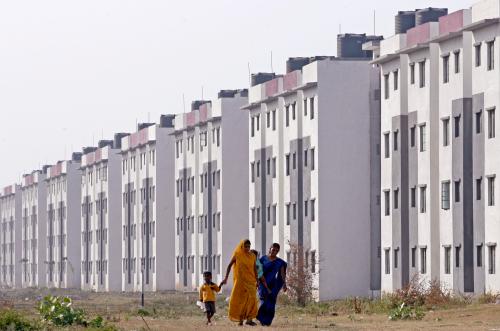Recently I spent a day at the U.S. Department of Housing and Urban Development (HUD), reviewing the results of a draft study on a housing program for people displaced by Hurricane Katrina. Although I’ve worked on many disasters elsewhere, it was fascinating to look at longer-term displacement from a U.S. disaster.
No one knows for sure how many people were displaced by hurricanes Katrina and Rita, but most estimates are in the 1-1.5 million range. While memories of Katrina – and the slow response to the disaster – will probably remain in the American consciousness for a long time, I think most people somehow assume that after a couple of years, everyone’s taken care of. And there’s also an assumption that the answer for people without homes is rebuilding and repairing homes that were destroyed or damaged in the disaster.
But FEMA (the Federal Emergency Management Agency), HUD and the many civil society organizations were well aware that after two and a half years, there were still people in acute need of housing. In response, HUD developed a program known as the Disaster Housing Assistance Program (or DHAP-Katrina for short) to provide transitional housing, through rental subsidies, to people who had nowhere to live. The program provided rental subsidies to some 33,000 people – mainly women, African-American and renters – who were not receiving assistance from HUD. The program was generally successful in helping people get back on their feet and seemed to fill a gap between temporary shelter (such as the FEMA trailers) and longer-term housing security. It wasn’t so clear, however, at least not in the expert panel meeting I attended, what long-term solutions people found after the program ended.
It was particularly interesting because two days later I found myself in the (more familiar) setting of a meeting at UN headquarters listening to a senior Haitian official, Mr. Clément Bélizaire, Director of Relocation and Rehabilitation of Precarious Neighborhoods, talk about housing issues after the devastating earthquake which left 1.5 million people homeless. ‘It has been two and a half years since the Haitian earthquake,’ he said, ‘and there are still 420,000 displaced Haitians living in 600 camps’.
Now, the U.S. and Haiti have very little in common when it comes to governmental capacity, infrastructure, economic resources, and most other factors but I found it fascinating that in both cases, the two governments recognized, after two and a half years, that there were still people in need of housing assistance and that reconstruction and repair weren’t the answer. In both cases, those in need of longer-term assistance tended to be renters rather than homeowners. In both cases, the price of rental housing had skyrocketed after the disaster and people who had managed to afford rents before the disasters were unable to do so afterwards. And in both cases, governmental agencies turned to subsidizing rents for displaced persons to address these needs. Mr. Bélizaire reported that 97 percent of Haiti’s displaced persons preferred rental subsidies over other solutions – mainly because they didn’t own homes. Rebuilding individual family homes didn’t meet the needs of those who were renters before the disasters. There are, of course, important differences between the Haitian and Katrina examples.
But the ultimate lessons I took away from the two very different meetings are that: finding housing solutions for those displaced by disasters (either in very rich or in very poor countries) takes a long time. Long after the television cameras have moved on, when people don’t have a secure place to live, the disaster continues. Furthermore, those who seem to be most in need of housing are among the most vulnerable in the communities and are disproportionately renters rather than homeowners.
Rental subsidies make a lot of sense in these contexts, and yet may not be long-term solutions. What happens when the subsidies end? In the case of those displaced by Katrina, a follow-on program was initiated and existing government programs for low-income housing provided a safety net for many of those affected. In the case of Haiti, it’s not at all clear what will happen when the rental subsidies run out. In both cases, I was struck by the close relationship between access to housing and employment or livelihoods. When people have jobs, full-time jobs at a decent wage, they are generally able to find housing solutions. But if they don’t, then rental subsidies are just another temporary solution.
Finally, access to housing is always a political issue. With some notable exceptions, renters almost always have less political clout than homeowners which may explain why rebuilding programs to support homeowners tends to get priority in disaster reconstruction. But since funding, attention and yes even compassion tends to be highest in the immediate aftermath of a disaster, I suggest that authorities undertake their contingency planning and begin their long-term recovery efforts with poor or low-income renters in mind.
The Brookings Institution is committed to quality, independence, and impact.
We are supported by a diverse array of funders. In line with our values and policies, each Brookings publication represents the sole views of its author(s).



Commentary
Housing and Disasters: Thoughts on Hurricane Katrina and Haiti
August 21, 2012